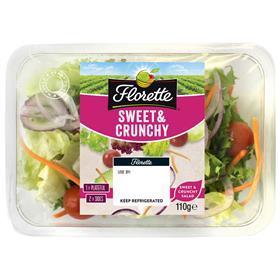
The figures make for impressive reading in the prepared produce market. A category in the midst of solid value and volume growth, the products are in tune with modern ways of living, indicating that a flat-lining probably won’t be on the horizon any time soon. Nevertheless, the category isn’t immune to the effects of pressure from the supermarket price war.
Matt Walton, head of sales at Fenmarc, tells FPJ: “In line with the overall market performance, trade has been positive, with all areas of the category seeing good growth. However, the prepared veg category continues to feel the pressure from deep cut wholehead vegetable pricing. During the recent periods of deep cut activity, particularly at Christmas and Easter, it has encouraged some customers who would usually buy the more basic end of the prepared range to move over to wholehead produce – hopefully temporarily, but this is something for us in the prepared sector to watch out for.”
Alistair Whitaker, category manager at Freshtime UK, notes: “Lines that are directly impacted by deep cut promotions on loose veg, like carrots, cauliflower and broccoli, are showing year-on-year decline, but the added-value lines that include veg prepared in roasting trays with a dressing are in growth.”
In a promising sign, it is both ends of the market that are contributing to the category’s success. Walton says: “Changing lifestyles and shopping habits have been prevalent to the category’s success, as well as the newly-recognised need for discounters to cater for their customers and create ranges in this category.
“On the flipside to the discounters, premium retailers also continue to see solid and sustainable growth with some inspiring innovation, which keeps customers buying into the category and choosing prepared veg over wholehead produce and ready meals.”
The weather, as ever, has been a notable talking point. Tony Walsh, category controller at Florette, says: “April saw low pressure, rain and even sleet and snow towards the end of the month. As a result, estimations suggest that total category growth during the colder weather was suppressed by £2.1 million or 3.9 per cent. However, when the weather has been warmer, weekly sales growth has been stronger than 2015.”
Nick Walker, agronomic manager at MyFresh, adds: “We’ve had a warm winter here in the UK, which has meant extra vigilance has been required with pests, though a cold April has helped with this. The cold April has, however, meant a delay on moving onto UK crop, and also some growers here in the UK have left their covers on for longer than usual, which has led to some damage on early crops. But we’ve been doing this a long time, have great relationships with our growers and have worked through any issues which have cropped up – we always expect the unexpected.”
In the foodservice side of the market, Andy Weir, head of marketing at Reynolds, says that potatoes and carrots are proving the trickiest products to source at present, “due to the lack of appropriate raw materials”.
He adds: “As far as prepared potatoes are concerned, in some instances it has been necessary to tweak our product specifications to ensure prices maintain
competitive. With regard to leaf, the shoulders of the European and UK seasons are generally challenging and this year is no different, but our suppliers are managing the changeover very well.”
Continuing on the subject of leaf, one of the category’s chief products as we head into the summer months, Walsh says: “One of the biggest talking points at the moment is competitive pricing of the leafy prepared category in supermarkets. Results from the latest market data to 24 April highlight year-to-date value growth of three per cent, and unit growth of 4.9 per cent. As unit growth is ahead of value, this trend is indicative of retailers continuing to drive volume with deflated prices and sub-pound activity.”
The added-value element of bowls continues to show great promise too: “As well as competitive pricing, data shows that year on year, bowls have remained a popular choice for consumers, as the penetration of bowls has risen by 20 per cent versus last year,” Walsh notes.
“However, as bowls continue to provide convenience to shoppers, product innovation is required to keep the level of interest high. Including a range of exciting new ingredients and offering more choice to the customer seems the next evolutionary step for bowls.”






No comments yet